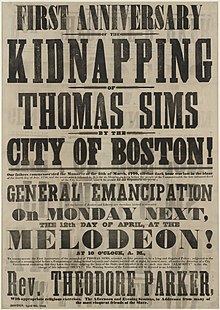
The Fugitive Slave Act or Fugitive Slave Law was a law passed by the 31st United States Congress on September 18, 1850, as part of the Compromise of 1850 between Southern interests in slavery and Northern Free-Soilers.
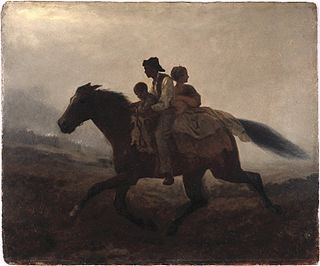
In the United States, fugitive slaves or runaway slaves were terms used in the 18th and 19th centuries to describe people who fled slavery. The term also refers to the federal Fugitive Slave Acts of 1793 and 1850. Such people are also called freedom seekers to avoid implying that the enslaved person had committed a crime and that the slaveholder was the injured party.

Calvin Fairbank was an American abolitionist and Methodist minister from New York state who was twice convicted in Kentucky of aiding the escape of slaves, and served a total of 19 years in the Kentucky State Penitentiary in Frankfort. Fairbank is believed to have aided the escape of 47 slaves.
In the context of slavery in the United States, the personal liberty laws were laws passed by several U.S. states in the North to counter the Fugitive Slave Acts of 1793 and 1850. Different laws did this in different ways, including allowing jury trials for escaped slaves and forbidding state authorities from cooperating in their capture and return. States with personal liberty laws included Connecticut, Massachusetts, Michigan, Maine, New Hampshire, Ohio, Pennsylvania, Wisconsin, and Vermont.

The fugitive slave laws were laws passed by the United States Congress in 1793 and 1850 to provide for the return of enslaved people who escaped from one state into another state or territory. The idea of the fugitive slave law was derived from the Fugitive Slave Clause which is in the United States Constitution. It was thought that forcing states to deliver fugitive slaves back to enslavement violated states' rights due to state sovereignty and was believed that seizing state property should not be left up to the states. The Fugitive Slave Clause states that fugitive slaves "shall be delivered up on Claim of the Party to whom such Service or Labour may be due", which abridged state rights because forcing people back into slavery was a form of retrieving private property. The Compromise of 1850 entailed a series of laws that allowed slavery in the new territories and forced officials in free states to give a hearing to slave-owners without a jury.
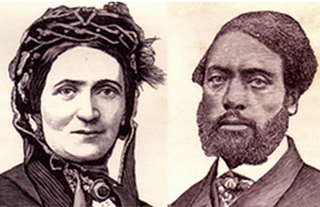
Ellen Craft (1826–1891) and William Craft were American abolitionists who were born into slavery in Macon, Georgia. They escaped to the Northern United States in December 1848 by traveling by train and steamboat, arriving in Philadelphia on Christmas Day. Ellen crossed the boundaries of race, class, and gender by passing as a white planter with William posing as her servant. Their escape was widely publicized, making them among the most famous fugitive slaves in the United States. Abolitionists featured them in public lectures to gain support in the struggle to end the institution.

Anthony Burns was an African-American man who escaped from slavery in Virginia in 1854. His capture and trial in Boston, and transport back to Virginia, generated wide-scale public outrage in the North and increased support for abolition.
James Batchelder (1830–1854) was the third United States Marshal to be killed in the line of duty. Batchelder was a truckman employed by the Marshals, and assigned to stand guard at the Boston Court House, where Anthony Burns, an escaped slave captured by slave-hunters, was imprisoned.
Edward Greely Loring was a Judge of Probate in Massachusetts, a United States Commissioner of the United States District Court for the District of Massachusetts and a judge of the Court of Claims. He was reviled in Massachusetts and much of the North for his ordering the return of fugitive slaves Thomas Sims and Anthony Burns to slavery in compliance with the Fugitive Slave Law of 1850. His action would result in his being removed as Judge of Probate.
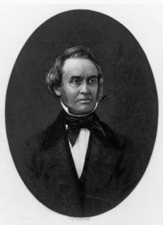
Robert Rantoul Jr. was an American lawyer and politician from Massachusetts.

Sherman Miller Booth was an abolitionist, editor and politician in Wisconsin, and was instrumental in forming the Liberty Party, the Free Soil Party and the Republican Party. He became known nationally after helping instigate a jailbreak for a runaway slave in violation of the Fugitive Slave Act.

A slave catcher is a person employed to track down and return escaped slaves to their enslavers. The first slave catchers in the Americas were active in European colonies in the West Indies during the sixteenth century. In colonial Virginia and Carolina, slave catchers were recruited by Southern planters beginning in the eighteenth century to return fugitive slaves; the concept quickly spread to the rest of the Thirteen Colonies. After the establishment of the United States, slave catchers continued to be employed in addition to being active in other countries which had not abolished slavery, such as Brazil. The activities of slave catchers from the American South became at the center of a major controversy in the lead up to the American Civil War; the Fugitive Slave Act required those living in the Northern United States to assist slave catchers. Slave catchers in the United States ceased to be active with the ratification of the Thirteenth Amendment.
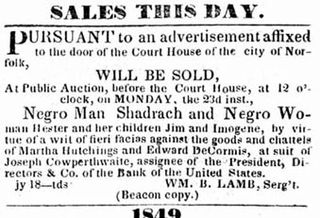
Shadrach Minkins was an African-American fugitive slave from Virginia who escaped in 1850 and reached Boston. He also used the pseudonyms Frederick Wilkins and Frederick Jenkins. He is known for being freed from a courtroom in Boston after being captured by United States marshals under the Fugitive Slave Act of 1850. Members of the Boston Vigilance Committee freed and hid him, helping him get to Canada via the Underground Railroad. Minkins settled in Montreal, where he raised a family. Two men were prosecuted in Boston for helping free him, but they were acquitted by the jury.

The pre-American Civil War practice of kidnapping into slavery in the United States occurred in both free and slave states, and both fugitive slaves and free negroes were transported to slave markets and sold, often multiple times. There were also rewards for the return of fugitives. Three types of kidnapping methods were employed: physical abduction, inveiglement of free blacks, and apprehension of fugitives. The enslavement, or re-enslavement, of free blacks occurred for 85 years, from 1780 to 1865.

The Boston Vigilance Committee (1841–1861) was an abolitionist organization formed in Boston, Massachusetts, to protect escaped slaves from being kidnapped and returned to slavery in the South. The Committee aided hundreds of escapees, most of whom arrived as stowaways on coastal trading vessels and stayed a short time before moving on to Canada or England. Notably, members of the Committee provided legal and other aid to George Latimer, Ellen and William Craft, Shadrach Minkins, Thomas Sims, and Anthony Burns.

Robert Morris was one of the first African-American attorneys in the United States, and was called "the first really successful colored lawyer in America."

Leonard Andrew Grimes was an African-American abolitionist and pastor. He served as a conductor of the Underground Railroad, including his efforts to free fugitive slave Anthony Burns captured in accordance with the Fugitive Slave Act of 1850. After the Civil War began, Grimes petitioned for African-American enlistment. He then recruited soldiers for the 54th Regiment Massachusetts Volunteer Infantry.
The Abolition Riot of 1836 took place in Boston, Massachusetts in the Massachusetts Supreme Judicial Court. In August 1836, Eliza Small and Polly Ann Bates, two enslaved women from Baltimore who had run away, were arrested in Boston and brought before Chief Justice Lemuel Shaw. The judge ordered them freed because of a problem with the arrest warrant. When the agent for their enslaver requested a new warrant, the spectators—mostly African-American women—rioted in the courtroom and rescued Small and Bates.

Samuel Edmund Sewall (1799–1888) was an American lawyer, abolitionist, and suffragist. He co-founded the Massachusetts Anti-Slavery Society, lent his legal expertise to the Underground Railroad, and served a term in the Massachusetts Senate as a Free-Soiler.
In Marion, Ohio, in July 1839, William Mitchell was seized by a group of men from Virginia, who alleged that he was an escaped slave. Mitchell, who had been living in Marion for at least a year, was placed on trial under Ohio's 1839 Fugitive Slave Act in the Court of Common Pleas, headed by Ozias Bowen. On August 27, in front of a packed courthouse, Bowen ruled against the Virginians and declared Mitchell to be free. After his ruling, the Virginians attempted to kidnap Mitchell. The crowd reacted in an effort to protect Mitchell, throwing projectiles at the Virginians while they were in the streets, and breaking into the town's armory and distributing weapons. Mitchell was soon freed and escaped to Canada.


